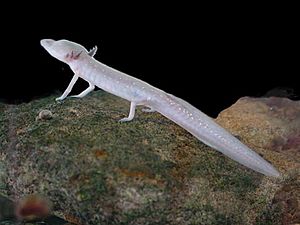Texas blind salamander facts for kids
Quick facts for kids Texas blind salamander |
|
|---|---|
 |
|
| Conservation status | |
| Scientific classification | |
| Synonyms | |
|
The Texas blind salamander (Eurycea rathbuni) is a very rare and endangered amphibian. It lives only in dark caves and underground waters near San Marcos, Texas in Hays County, Texas. This special salamander is a troglobite, meaning it spends its whole life deep inside caves. It also lives in stygofaunal habitats, which are underground water systems like the Edwards Aquifer.
This salamander looks a bit like the olm, another cave salamander from Europe. However, the Texas blind salamander is not as long and has more fingers and toes. The olm has only three digits on its front legs and two on its back legs.
Description
The Texas blind salamander has a wide, flat face and head. Its eyes are very small and covered by skin, so it cannot see. Like other neotenous salamanders, it keeps its external gills even as an adult. These feathery gills help it breathe oxygen from the water.
An adult salamander is about 13 cm (5 in) long. It has four digits on its front legs and five digits on its back legs. If it loses its tail or legs, this amazing creature can grow them back!
Its diet depends on what food floats into its cave home. It eats blind shrimp, snails, and small creatures called amphipods. Scientists are not sure if anything hunts the Texas blind salamander. Another fish, the stygobitic catfish Satan eurystomus, lives in the same aquifer. It might be a predator, but it lives in a very small area, so they might not often meet.
Distribution and Habitat
Texas blind salamanders have been found in seven different places. These spots are mostly in the Purgatory Creek system and along the San Marcos Fault near San Marcos, Texas.
Adults and young salamanders are very good at living in underground cave streams. Many probably live in deep areas that people cannot reach. They have been found in deep pools where the water moves slowly. The water temperature stays almost the same, around 21–22 °C (70–72 °F). The first salamanders of this type were found in 1895. They came from a new well that pulled water from 58 metres (190 ft) below the ground.
Reproduction and Life Cycle
Scientists do not know much about when these salamanders breed. One scientist, Dunn, saw a salamander lay a few eggs in March. Another salamander collected in the fall had sperm stored. Very young salamanders have been found all year round. This suggests they might breed at different times throughout the year.
Bechler watched how these salamanders courted in a lab. The female usually starts the courtship. She rubs her chin on the male's back. She might also rub her cloaca (a body opening) on nearby rocks. If the male does not respond, the female might gently nip him or scratch the ground with her back legs.
Eventually, the female moves over the male's tail and rubs her snout near the base of his tail. The male then arches his body and fans his tail between her legs. The female rubs her snout faster over the male's tail base. The male might then lead her forward and repeat the actions. He slowly vibrates the front part of his tail.
Finally, the male bends his body into an S-shape and places a packet of sperm, called a spermatophore, on the ground. He then leads the female forward until she picks up the sperm packet with her cloaca. The spermatophore is a white, crescent-shaped sperm cap on a clear, jelly-like base. This species grows up slowly and does not produce many offspring. Females lay about 5 small groups of eggs each year.
Conservation
Texas blind salamander populations are sensitive to water pollution in the ground. They are also at risk if too much underground water is used up. This happens when people take more water for homes or businesses than the ground can refill.
Scientists watch the flow of the San Marcos River to check on the long-term water supply. As of 2004, the number of Texas blind salamanders was stable, according to a group called IUCN. A review in 2021 said that efforts to improve their status were partly done. However, it warned that current limits on water use do not consider that droughts might happen more often and be stronger because of climate change.
See also
 In Spanish: Salamandra ciega de Texas para niños
In Spanish: Salamandra ciega de Texas para niños



